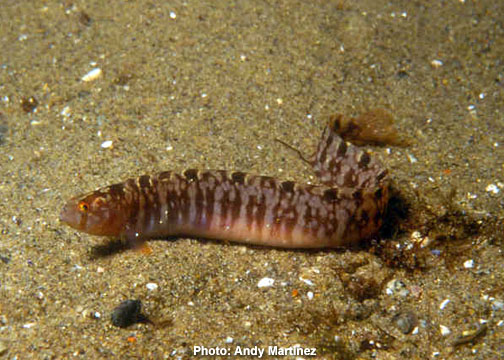Rock gunnel
Atlantic butterfish ( Pholis gunnellus )
The Atlantic butterfish ( Pholis gunnellus ) is a slender marine fish from cold regions of the northern Atlantic. Its range extends from the Kanin Peninsula in the Barents Sea via the White Sea, Spitzbergen and Iceland to La Rochelle. It is also found in North and Baltic Sea. In the northwestern Atlantic, he lives on the coast of Labrador to Delaware Bay.
Features
The Atlantic fish butter has an elongate band-shaped body and is 30 cm long. It is brownish in color. Dorsal, caudal and anal fin are separated. The dorsal fin is long and takes up almost the entire body length. Along the base of the long dorsal fin located 9 to 13 black eye spots that are surrounded know. The anal fin extends over the rear half of the body. The lateral line runs along the middle of the body.
Way of life
The Atlantic butterfish lives spatial fidelity on the sea floor of tide pools to depths of 35 meters. Animals that fall dry at low tide, can breathe air and survive hidden under rocks or seaweeds. In winter it migrates to greater depths of about 100 meters or less. The preferred habitat is rocky and overgrown with algae or seaweed. It feeds mainly on small crustaceans, Vielborstern, molluscs and fish roe. The Atlantic butterfish multiplies in the winter months from November to January. The 80 to 200 eggs are laid in a clump under rocks or in an empty clam shell and guarded by the male until hatching of juveniles.
Use
The Atlantic butterfish has no economic significance and is not fished. When the fish fillets offered under the name " butterfish " in the trade is snake mackerel ( Gempylidae ) that are not related to the butter fish.










